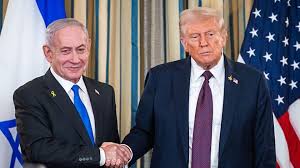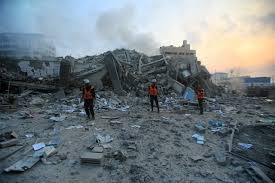In late September 2025, former U.S. President Donald Trump unveiled a bold 20-point peace plan aimed at ending the long and deadly Gaza conflict. While Israel has expressed support for the proposal, Hamas and other Palestinian groups remain cautious or resistant. The plan is ambitious in scope, touching on ceasefire arrangements, governance, security, reconstruction, and political rights. As diplomatic efforts intensify, the world watches keenly to see whether this proposal can break a dangerous cycle of violence.
What the Plan Proposes
Trump’s plan designs a multi-step outline to stabilize Gaza and create conditions for a long peace. Some of its major points are as follows:
- Once the proposal is accepted by both sides, an immediate ceasefire and military operations will be suspended.
- Without 72 hours of Israel’s public acceptance, all hostages, living or dead, return.
- A large number of Palestinian prisoners were released by Israel, including prisoners who were sentenced to life imprisonment and prisoners detained after October 7, 2023.
- Sorry for those members of Hamas who are committed to peaceful co-existence and neutrality to weapons; a Safe route for those wishing to leave Gaza.
- The rule of Gaza by a neutral, technical democratic Palestinian Committee under the supervision of an International “Peace Board” under the chairmanship of Trump and a neutral, technical democratic Palestinian Committee, including external experts like Tony Blair.
- With the bay-back or regeneration programs, the immersion and decommissioning of all arms and military infrastructure are under independent monitoring.
- International Standing Force (ISF) is working with the Palestinian police, which is working, protecting boundaries, assisting in rebuilding, and stopping arms influx
- There is no possession or possession of Gaza by Israel; Graduates return by the IDF is tied to safety standards
- Major reconstruction and development efforts for “New Gaza” – starting a special economic sector to rebuild infrastructure, electricity, water, hospitals, roads and revive the economy.
- Respect for Palestinian Rights: Residents will not be forced to leave Gaza; Those who choose to leave can return. This plan envisions the final political horizon for Palestinian self-determination, which is associated with improvements and stability
- Inter-religious dialogue, regional guarantee and inspection mechanisms help to change stories and discourage renewed violence
While the plan offers 20 distinct points, much of its success depends on how those points are defined in detail, the sequencing, and whether parties agree to implement them sincerely.
Support, Skepticism, and Reactions
Israel’s response
Israeli Prime Minister Benjamin Netanyahu publicly welcomed the scheme, supporting several security and governance components. Israel has said that if Hamas rejects the agreement, it can “finish” the military.
Hamas and Palestinian Group
Hamas has not formally agreed to this scheme. Some sources suggest that they are carefully reviewing it and may interact on conditions. Some officials believe that Hamas is likely to reject the plan or make heavy amendments.
However, the Palestinian Authority welcomed the efforts and expressed support for a comprehensive agreement including hostages, human relief, and state rights.
Regional and global reaction
Many Arab and Muslim-Bahul countries issued a joint statement supporting Trump’s “honest efforts” and supporting the theory of the scheme aid, the withdrawal of Israel and the path of peace. Countries such as Jordan, the United Arab Emirates, Türkiye, Saudi Arabia, Qatar, Egypt, Pakistan and Indonesia expressed their desire to cooperate.
In the West, the European leaders and the European Union also welcomed the proposal as an optimistic step towards ending the struggle.
Analyst and critic
While many people see the plan as the most concrete peace proposal over the years, analysts have warned that many elements are unclear, unimplemented or impractical until all sides are fully committed.
The main uncertainties include how to apply disarmament, how to rule Gaza under external monitoring, possible resistance from Hamas, and whether regional actors will apply promises. Some people see it as an adventure signal for optics compared to actionable politics until sufficient diplomatic support comes out.
Challenges & Key Issues Ahead
- Trust and Enforcement
A major hurdle is trust: both Israel and Hamas have strong incentives to back out or reinterpret terms. Ensuring compliance—especially disarmament, prisoner exchange, and troop withdrawal—will require firm guarantees and credible enforcement mechanisms.
- Hamas’s Role
Excluding Hamas from governance, as the plan insists, is a contentious point. Hamas has controlled Gaza for years and retains political and military influence. Insistence on full disarmament and exclusion may trigger resistance or even rejection.
- Governance & Sovereignty
Transferring governance to a technocratic committee supervised by an international board led by Trump raises serious questions about democratic legitimacy, accountability, and Palestinian agency. Many will see it as foreign control over Palestinian destiny.
- Reconstruction Funding & Implementation
Rebuilding Gaza will demand enormous financial resources and logistical planning. Ensuring that aid reaches people effectively, without diversion or obstruction, will require strong international mechanisms and local capacity.
- Political Horizon
While the plan hints at eventual Palestinian self-determination, it makes Palestinian statehood conditional on performance and reform. This may be seen by many as delaying or weakening the demand for an equal and sovereign Palestine.
- Regional Stability & Guarantees
The success of the plan depends heavily on regional actors, including Egypt, Jordan, Saudi Arabia, Qatar, and Turkey, to enforce guarantees, mediate disputes, and ensure border security. Without strong regional backing, any agreement may unravel.
What Happens Next?
- Hamas’s decision: The Hamas leadership is given several days to accept or propose amendments. If they reject the plan outright, the initiative could falter.
- Implementation of initial steps: If accepted, immediate steps would include a ceasefire, withdrawal of Israeli forces to agreed lines, cessation of military action, and return of hostages.
- Deploying Stabilization Forces: The plan calls for an international stabilization force to collaborate with the newly established Palestinian police forces and assist in maintaining security during the transition.
- Reconstruction efforts: Rebuilding infrastructure, housing, hospitals, roads and launching economic initiatives will be a high priority.
- Political dialogue: Long-term negotiations regarding Palestinian political rights, reform of the Palestinian Authority, and final steps toward statehood are in the outer stages of planning.
Why this plan matters
Nearly two years on, the Gaza war has taken thousands of lives and caused devastating humanitarian suffering. The conflict has also threatened broader regional stability and strained international diplomacy.
Donald Trump’s 20-point plan is significant because it is one of the most detailed and vocal peace proposals in recent years. It seeks to link immediate relief – ceasefire, hostage recovery – with long-term transformation of Gaza’s security, governance and economy.
Even if the plan is only partially accepted or implemented, it can reset expectations, sharpen diplomatic focus and provide a blueprint for future negotiations. However, its fate depends on coordination between Israel, the Palestinians and regional stakeholders and realism in implementation.












